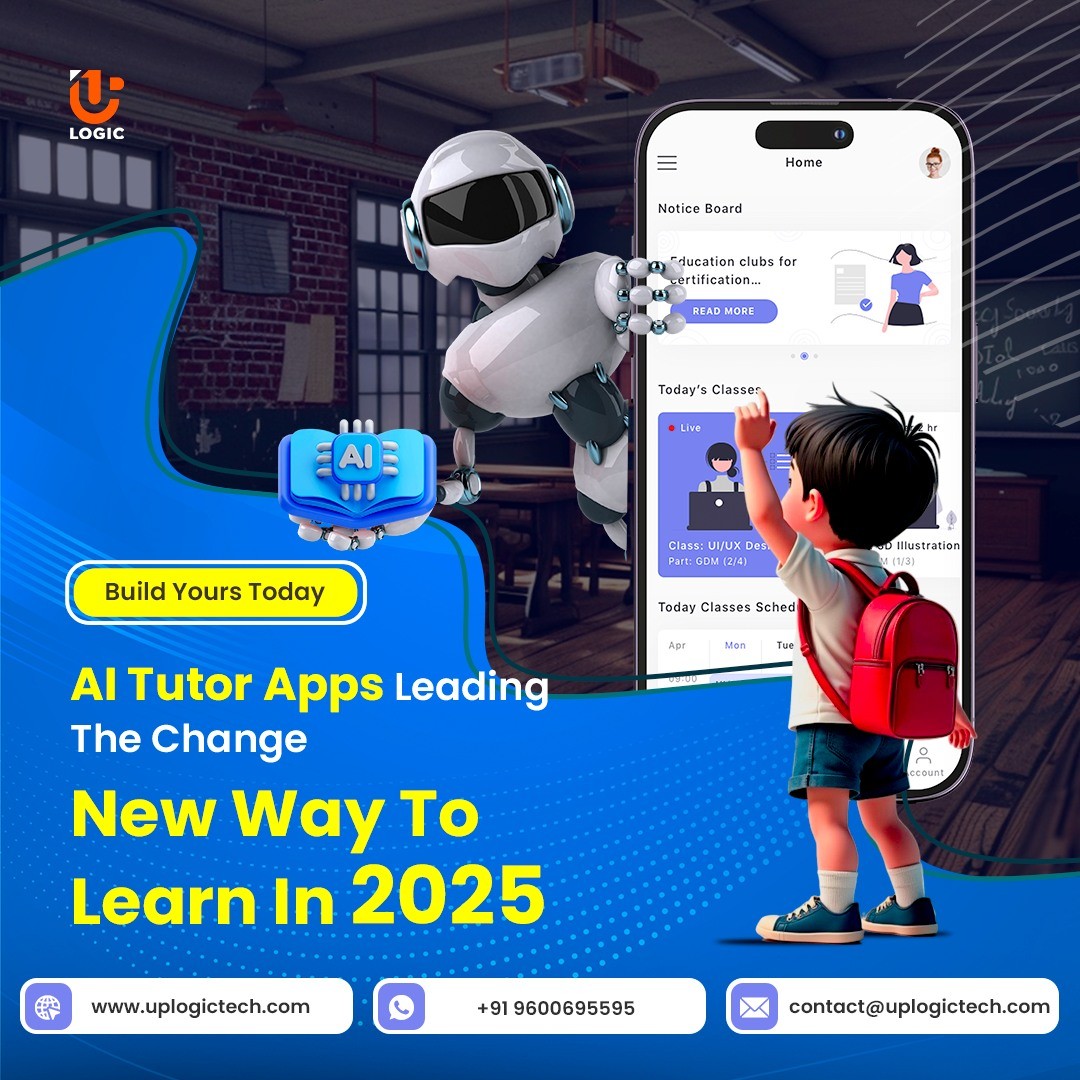Whether you’re a startup or an established brand, we deliver impactful digital strategies that boost your online presence and drive long-term growth. Choose Techfinad — your trusted digital growth partner in Noida.
Visit Us : https://techfinad.com/
Launch a full-featured, white-label Amazon clone platform that supports multiple vendors, product categories, efficient search & filters, secure checkout, reviews, and full admin control. With source code access and scalability built in, your branded marketplace can grow without limits.
🔗 https://oyelabs.com/amazon...
#AmazonClone #EcommerceMarketplace #MultiVendorApp #WhiteLabelEcommerce #oyelabs #OnlineMarketplace #clonescript #RetailPlatform

Amazon Clone Script - #1 Ready-to-Launch Ecommerce App
Amazon Clone - Launch your own online multivendor marketplace. Online store script is 100% customizable, feature-rich, ready to go e-commerce solution.
https://oyelabs.com/amazon-clone/Planning to build a healthcare app like Pristyn Care? This guide explores essential features such as online consultations, appointment booking, electronic health records, and digital payments.
for more: https://duplextech.com/blo...
Improve your search rankings and drive organic traffic with expert SEO services from Elysian Digital Services. From on-page optimization to technical SEO and link building, we help businesses grow online.
Learn more : https://elysiandigitalserv...

Premium SEO Services in Delhi | Elysian Digital Services
Boost your rankings with expert SEO services in Delhi. Get on-page SEO, backlinks, and keyword optimization to drive traffic and leads
https://elysiandigitalservices.com/seo-services/#Nante #IndustrialConcealedSocket #PowerSafety #EdgeComputing #SmartFactory
The web market has increased massively, and organizations are now willing to dive deep into this fruitful industry as they understand that demand for online platforms is on the rise. A lot of retail store owners are seeking online options to display their products and appeal to a greater number of people, and as a result, increase their sales.
If you are considering moving your retail store online, this blog is a must-read as it includes major factors that render the Amazon clone app a valuable investment.
What is an Amazon Clone?
The dynamics of the e-commerce business are changing fast with the current technologies and features. Reports indicate that the e-commerce market will rise to a trillion 6.3 in the next few years.
Therefore, the Amazon clone script is increasingly becoming popular, with a large variety of functions to facilitate business development. It is a high-quality, white-labeled solution that can be customized and deployed to meet special business needs.
These scripts are built with several functionalities, such as convenient payment gateways and integration with all types of merchant outlets, adapted to the competitive market demands and local needs of the customers.
The main characteristics of such applications are product categorization, customized cart management, live tracking, a multi-currency payment gateway, an advanced admin panel, and many more. These features enable the business to reach a wide customer base worldwide and also provide the capability of running and managing the systems smoothly and efficiently.
Final Words
Entrepreneurs looking to start an online shopping business can use this blog as a guide and develop an Amazon clone app with the features mentioned above. These features will help build a strong customer base and drive sustainable business growth.
https://www.trioangle.com/...
#AmazonClone #AmazonCloneScrip
Taxi apps have revolutionised the way people commute in today's fast-paced digital environment. Selecting the best taxi app development company is essential, whether you're an established company looking to increase your online presence or a startup hoping to start your own ride-hailing service.
Locating a development partner who is aware of your particular market needs, consumer behaviour, regulatory landscape, and competitors is crucial to the success of your taxi app.
The procedures and factors you need to take into account when looking for a taxi app development business that really fits your industry will be covered in this in-depth guide.
Summing Up!
Selecting the best taxi app development business necessitates more than just technical know-how; it also calls for a thorough comprehension of your target market, user trends, and regional transportation requirements.
Select a development team that shares your vision by making sure they provide scalable and customisable solutions, thoroughly describing your business objectives, investigating possible partners, and assessing their portfolios.
In addition to developing an app, the ideal partner assists you with developing a competitive, user-friendly, and long-lasting platform that is customised for your target market.
Take the time to choose wisely; it’s an investment in your success.
https://www.trioangle.com/...
#TaxiAppDevelopment #taxibookingapp #OnDemandTaxiApp #TaxiAppUSA #SmartTaxiSolutions #DigitalTaxiSolutions #TaxiStartup
Trusted Online Quran Classes UK for Kids & Adults and learn from qualified teachers at your own pace. Our online Quran classes provide flexible schedules, personalized lessons, and expert guidance for beginners and advanced learners. With interactive sessions, kids and adults can build a strong foundation in Tajweed, recitation, and understanding the Quran from home.
Visit - https://alnoortutoring.com
The eCommerce industry has witnessed immersive growth, fueled by new technology innovations and evolving user demands.
AliExpress Clone is one of the top on-demand platforms with a scalable architecture, unique layouts, and standard vendor management. It opens a new opportunity for startups to stand out in a competitive marketplace.
This blog provides a complete guide to building a multi-vendor app using an AliExpress clone script. We covered its essential features, development steps, and latest trends.
Dive in.
Aliexpress Clone: An Introduction
Don’t you know what an AliExpress clone is? Here’s a short overview of it. Let’s check in.
An AliExpress clone is a ready-made solution inspired by the original AliExpress business model, designed with its core functionalities intact. This connects every single user who wants to order products through an online medium. They can compare prices across multiple vendors and finally buy a product from a preferred store. It increases user convenience and satisfaction.
This eCommerce clone script streamlines the complete end-to-end purchasing process with advanced features, including user registration, multiple delivery addresses, shipment tracking, and secure payments.
Partner With Trioangle and Start Today!
Obviously, you are at the right place to start and implement your multi-vendor marketplace idea.
Trioangle's AliExpress Clone Script can help you turn your idea into a robust and revenue-generating eCommerce platform.
Connect with our experts to acknowledge business goals and craft solutions that meet your target audience's needs.
Subscribe now!
https://www.trioangle.com/...
#AliExpressClone #AliExpressCloneScript #AliExpressLikeApp #MultiVendorEcommerce #MarketplaceSoftware #EcommerceScript #ReadymadeEcommerce #B2BMarketplace #OnlineMarketplace
Step into the booming travel market with a customizable Airbnb clone app from Oyelabs. Equipped with features like advanced property listings, secure online bookings, host–guest chat, smart geolocation search, dynamic pricing, and a robust admin panel, this white-label solution gives you complete source code control and brand flexibility to scale globally.
https://oyelabs.com/airbnb...
#AirbnbCloneApp #VacationRentalPlatform #PropertyBookingSolution #OnDemandRentalApp #oyelabs #CustomCloneApp #TravelTech #WhiteLabelSolution

Airbnb Clone - Launch Online Vacation Rental Marketplace
Airbnb clone is a ready-to-launch rental booking platform and a fully customizable script that can help you launch your rental business within 72 hours!
https://oyelabs.com/airbnb-clone/Connect students and tutors instantly with our advanced Tutor App Solution featuring live video classes, easy scheduling, in-app chat, secure payments, and real-time notifications. Start your online tutoring business today and make learning accessible anytime, anywhere.
Get Started Now: https://www.uplogictech.co...
#TutorAppDevelopment #EdTechSolutions #OnlineLearningApp #DigitalEducation #ElearningPlatform #LiveTutoring #OnDemandTutors #VirtualClassroom #EducationApp #OnlineTeaching #StudyAnywhere #SkillDevelopmentApp #TeacherStudentApp #LearningMadeEasy #EducationTechnology #FutureOfEducation #BuildYourApp #EdTechInnovation #StudySmarter #TeachOnline
Transform the travel industry with Oyelabs’ Airbnb clone app—a fully customizable, white-label solution featuring advanced property listings, secure online bookings, host–guest messaging, location-based search, and dynamic pricing controls. With complete source code ownership and scalability, you can launch your rental marketplace and grow your brand globally.
🔗 https://oyelabs.com/airbnb...
#AirbnbClone #VacationRentalPlatform #PropertyBookingApp #TravelTech #oyelabs #CustomCloneApp #WhiteLabelRentalSolution #RentalMarketplace

Airbnb Clone - Launch Online Vacation Rental Marketplace
Airbnb clone is a ready-to-launch rental booking platform and a fully customizable script that can help you launch your rental business within 72 hours!
https://oyelabs.com/airbnb-clone/At PratsDigital, I specialize in helping architects grow online with proven #seo #strategies designed specifically for the architecture and design industry.
https://pratsdigital.in/se...
Step into the booming travel market with a customizable Airbnb clone app from Oyelabs. Equipped with features like advanced property listings, secure online bookings, host–guest chat, smart geolocation search, dynamic pricing, and a robust admin panel, this white-label solution gives you complete source code control and brand flexibility to scale globally.
🔗 https://oyelabs.com/airbnb...
#AirbnbCloneApp #VacationRentalPlatform #PropertyBookingSolution #OnDemandRentalApp #oyelabs #CustomCloneApp #TravelTech #WhiteLabelSolution

Airbnb Clone - Launch Online Vacation Rental Marketplace
Airbnb clone is a ready-to-launch rental booking platform and a fully customizable script that can help you launch your rental business within 72 hours!
https://oyelabs.com/airbnb-clone/Hello web development enthusiast,
The global e-commerce industry is growing steadily, expected to reach around $6 trillion by 2025. In particular, Amazon is a dominant platform in the marketplace, delivering a large products, excellent user interaction, and modern features that draw millions of buyers and sellers.
Jump in and learn how to properly design an Amazon clone website with a structured day-wise development plan.
Get started now.
What is the Best eCommerce Script?
An eCommerce script is a pre-built code program that allows businesses to swiftly develop and manage diverse stores. It offers basic functionality like as product listings, shopping carts, payment gateways, and order management, allowing merchants to sell products or services online more efficiently.
The key qualities that make it the best eCommerce script include customizability, mobile responsiveness, fast performance, multi-vendor support, reliable technical support, analytics, and reporting. It ensures a robust platform development experience and an engaging shopping journey.
Tying Up
Ultimately, we believe that this day-wise plan will help you successfully develop an Amazon clone website. With diverse solutions available, choose one of our best eCommerce script to build your powerful multi-vendor platform.
You're in the right place. Contact us today!
https://www.trioangle.com/...
#EcommercePlatform #TechForBusiness #AmazonCloneScript #USAeCommerce #EcommerceLondon #MiddleEastEcommerce #SAOnlineStore #OnlineMarketplace #MultiVendorMarketplace #DigitalRetailUSA #UAEStartupScene #MarketplaceTrends
Step into the online dating industry with a Tinder clone app that’s fully customizable and packed with advanced features. From AI-based matchmaking and geolocation swiping to real-time chat and video calls, Oyelabs delivers a white-label solution that gives you full control over branding and scalability. Build a modern dating app that rivals Tinder, Bumble, or Hinge—without starting from scratch.
Explore now 👉 https://oyelabs.com/tinder...
#tinderclone #DatingAppDevelopment #MatchmakingApp #OnDemandDatingApp #oyelabs #SwipeRightApp #WhiteLabelDatingApp #DatingCloneScript

Tinder Clone – Readymade On-Demand Dating App Script
Tinder clone script to launch your online dating app faster with our 100% customizable script, free 2 months of support, and advanced, user-friendly features.
https://oyelabs.com/tinder-clone/Welcome, aspiring ecommerce entrepreneurs!.
The multi-vendor marketplace is booming vigorously, fueled by mobile penetration and innovative solutions. It provides immense opportunities for businesses to drive revenue and growth. An Etsy clone script is one of the most promising platforms for turning your vision into a thriving reality.
This blog guides you through the building steps and proven strategies for the Etsy Clone app. Get ready to discover here!.
What is the Etsy Clone Script?
An Etsy clone script is a built-in solution that duplicates the core features of the multi-vendor app Etsy. This is designed with dedicated features to help businesses create their own online selling app without starting development from scratch.
It allows buyers to search and purchase products from different sellers through effortless order placement and secure shipping. This white-label marketplace script works smoothly on both web and mobile platforms, offering a new shopping experience for buyers and sellers.
With this ready-made solution, you can deploy the app in a few days and quickly attract the modern community of users.
How the Etsy Clone Revolutionizes Your Business?
Now, let’ see the revolutionizing factors that make the Etsy Clone a game-changer of an eCommerce business. Dive in.
In a Nutshell,
We believe this blog provides you with detailed insights to build a successful Etsy clone app that delivers seamless buying experiences.
For more tips and updates, subscribe to my account and get upcoming guides on e-commerce marketplace app development.
Stay tuned!.
https://www.trioangle.com/...
#EtsyClone #EcommerceClone #MarketplaceScript #OnlineMarketplace #EcommerceBusiness #EtsyCloneUSA #EtsyCloneUK #EtsyCloneAustralia #EtsyCloneCanada
https://webitech.pk
The taxi sector is flourishing like never before, allowing businesses to expand, develop, and capture new market possibilities.
Have you ever thought about how the cab booking software can transform your business? It helps you streamline bookings, optimize driver management, and enhance customer satisfaction. Don’t get stressed.
This brief blog outlines critical factors to consider when selecting cab booking software that drives growth and profitability.
Get started now!
What is Cab Booking Software?
A cab booking software is a built-in technology solution with core functionalities designed to power an on-demand mobility app. It facilitates urban users to book a cab or taxi ride with a single tap using mobile or web platforms.
The global taxi market is expected to reach $592.96 billion by 2033, up from $274.6 billion in 2024, boasting a CAGR of 8.93% from 2025 to 2033.
In a Nutshell
Hurray! We’ve reached the end. This is the moment to build your online cab booking app and transform your taxi service into a smart and highly profitable venture.
The right cab booking software can accelerate your launch, streamline operations, and stand out in a rapidly expanding industry.
Don't wait, ride the wave of innovation today!
https://www.trioangle.com/...
#TaxiSoftwareUSA #USATaxiTech #DispatchSoftwareUK #UKTransportTech #TaxiAppCanada #RideshareAU #TaxiSoftwareGermany #FleetManagementSoftware #RideshareTechnology #taxidispatchsoftware
(Unspoken Truths | Digital Identity, Influence & Authentic Growth)
They told you to “be professional” and “post consistently.”
But they didn’t teach you how to build trust, tell your story, and grow a brand that actually connects in a world flooded with noise.
Let’s dive into what they don’t teach you:
Personal branding online isn’t about perfection — it’s about clarity, consistency, and connection.
WHAT THEY DON’T TEACH YOU:
1. You Are Already a Brand — Whether You Intend to Be or Not
Every post, comment, share, or bio tells a story about you.
The question is: Are you shaping that story — or letting it happen by accident?
2. Authenticity Is Louder Than Aesthetic
You can have perfect visuals…
But if people can’t feel your values, your mission, or your voice — they won’t connect.
Your personality is your real brand advantage.
3. You Don’t Need to Be an Expert — You Need to Be Real
People follow journeys, not finished products.
Share the process, the lessons, the missteps — that’s what builds loyalty.
4. Clarity Beats Going Viral
If people don’t know:
Who you are
What you stand for
What you offer
…then the likes mean nothing.
Be known for something clear — not everything trendy.
5. Posting Consistently Means Nothing Without Purpose
You don’t need to post every day — but you do need to show up intentionally.
Each post should answer: “What do I want my audience to feel, learn, or do?”
6. Your Story Is Your Power — Even the Messy Parts
-Why you started
-What you've overcome
-What keeps you going
Your lived experience builds credibility and emotional resonance.
7. Community > Followers
100 engaged supporters > 10,000 silent followers.
Build trust, respond to comments, give value — and your brand will grow naturally.
8. Consistency Wins the Long Game
You won’t go viral overnight.
But if you keep showing up with value, clarity, and heart?
You’ll build something that lasts longer than trends.
PERSONAL BRAND CHECKLIST:
-Can I explain who I am, what I do, and who I serve in one sentence?
-Does my content reflect my values, voice, and vision?
-Am I building trust through storytelling, not just selling?
-Do I show up regularly without burning out or faking it?
-Am I nurturing real connections, not chasing vanity metrics?
FINAL THOUGHT:
They didn’t teach you how to build a personal brand online — because they underestimated the power of everyday voices in the digital age.
But now you know:
Your brand isn’t what you say — it’s what people feel when they see or hear from you.
Don’t just market — connect. Don’t just post — lead. Don’t just grow — build meaning.
While both Iranian and Vietnamese cyber groups engage in state-sponsored cyber operations, their primary motivations, geopolitical contexts, and consequently, their tactics and targets, differ significantly.
Iranian Cyber Groups (e.g., APT33/Elfin, APT34/OilRig, APT35/Charming Kitten, MuddyWater)
Main Motives:
Iran's cyber activities are strongly driven by its geopolitical aspirations, regional rivalries (especially with Saudi Arabia and Israel), and desire to counter international sanctions. Their motivations include:
Espionage: Gathering intelligence on political, military, and economic developments, particularly in the Middle East, U.S., Europe, and Israel.
Disruption and Retaliation: Disrupting critical infrastructure, especially against perceived adversaries (e.g., in response to sanctions or political actions). They are willing to engage in destructive attacks.
Influence Operations: Spreading propaganda, manipulating public opinion, and sowing discord in rival nations.
Intellectual Property Theft (Secondary): While they do engage in this, it's often more opportunistic or tied to specific military/dual-use technologies rather than broad economic development.
Internal Control: Surveillance and repression of dissidents, both domestically and abroad.
Tactics:
Iranian groups often leverage a blend of technical sophistication and social engineering.
Aggressive Spear-Phishing & Social Engineering: Highly sophisticated and persistent phishing campaigns are a hallmark. They often impersonate legitimate entities (journalists, academics, government officials, recruiters) to build trust and trick targets into revealing credentials or downloading malware. They're known for using compromised accounts for further phishing.
Exploitation of Known Vulnerabilities: They are quick to exploit newly disclosed vulnerabilities (N-days) in widely used software and internet-facing systems (VPNs, firewalls, Exchange servers) to gain initial access.
Living Off The Land (LotL) & OSINT: They frequently use legitimate system tools (PowerShell, RDP, Mimikatz) and open-source intelligence (OSINT) to evade detection and understand victim networks.
Web Shells & Backdoors: Deployment of web shells for persistent access and custom backdoors.
Destructive Malware/Wipers: Iranian groups have a history of deploying destructive malware (e.g., Shamoon, ZeroCleare) to wipe data and disable systems, particularly against targets in the energy and industrial sectors.
Hybrid Operations: Increasingly, they combine hacking and data theft with information operations, leaking stolen data online, and using social media for amplification and harassment.
Ransomware (Collaborative/Opportunistic): While not their primary goal like North Korea, some Iranian groups have been observed collaborating with cybercriminal ransomware affiliates or directly deploying ransomware for financial gain or disruption.
Targets:
Middle East Region: Heavily focused on Gulf Cooperation Council (GCC) countries (especially Saudi Arabia, UAE), Israel, and other regional rivals.
Government & Military: Foreign ministries, defense contractors, intelligence agencies, and government officials, particularly those involved in nuclear policy, sanctions, or regional security.
Energy Sector (Oil & Gas): A long-standing target for both espionage and potential disruption, reflecting Iran's strategic interests.
Critical Infrastructure (OT/ICS): Increasing focus on industrial control systems and operational technology, potentially for pre-positioning or disruptive attacks.
Telecommunications & Financial Services: For intelligence gathering and network access.
Journalists, Academics, Dissidents, Human Rights Activists: Both within Iran and among the diaspora, for surveillance and repression.
Vietnamese Cyber Groups (e.g., APT32/OceanLotus, APT30/Naikon)
Main Motives:
Vietnamese cyber operations are strongly linked to national economic development, protecting sovereignty claims (especially in the South China Sea), and maintaining political stability.
Economic Espionage: Stealing intellectual property, trade secrets, and competitive intelligence to support Vietnamese industries and accelerate economic growth. This is a very significant motivation.
Political Espionage: Gathering intelligence on foreign governments, political organizations, and diplomats relevant to Vietnam's geopolitical interests, particularly concerning regional rivals and partners.
Surveillance and Monitoring: Tracking and monitoring political dissidents, journalists, NGOs, and foreign entities perceived as a threat to the ruling party or national stability.
South China Sea Disputes: Gaining intelligence on rival claimants and international actors involved in the South China Sea disputes.
Tactics:
Vietnamese groups often demonstrate high levels of sophistication and persistence, with a focus on long-term access and stealth.
Sophisticated Spear-Phishing: Highly customized and contextualized spear-phishing emails, often impersonating trusted contacts or organizations, are a primary initial access vector.
Watering Hole Attacks: Compromising websites frequented by specific targets and implanting malware to infect visitors.
Custom Malware and Backdoors: Development and use of sophisticated custom malware (Remote Access Trojans, info-stealers) designed for covert data exfiltration and persistent access.
Exploitation of Zero-Day and N-Day Vulnerabilities: While less frequent than Iranian groups' aggressive N-day exploitation, they are capable of exploiting zero-days.
Supply Chain Attacks: There have been instances where Vietnamese groups have targeted software or hardware vendors to compromise their clients downstream.
Leveraging Cloud Services: Using legitimate cloud services for command and control (C2) or data exfiltration to blend in with normal network traffic.
Evasion Techniques: Employing various techniques to avoid detection by security software, including code obfuscation and anti-analysis checks.
Targets:
Southeast Asian Governments: Particularly those involved in the South China Sea disputes, for political intelligence.
Foreign Businesses & Multinational Corporations: Across various sectors (e.g., automotive, media, hospitality, manufacturing, technology, healthcare, e-commerce) for economic espionage and IP theft.
Political Dissidents & Human Rights Activists: Both domestic and international, for surveillance and control.
Journalists and NGOs: Especially those reporting on Vietnam or human rights issues.
Critical Infrastructure (Limited Public Reporting): While less publicly highlighted than Iranian or Chinese groups, there have been some reports of Vietnamese groups targeting critical infrastructure, but often for intelligence gathering rather than overt disruption.
Comparison Summary:
Feature- Iranian Cyber Groups----
Primary Motive- Geopolitical influence, regional rivalries, countering sanctions, disruption, espionage, retaliation.
Willingness for Disruption- High – known for destructive attacks/wipers.
Key Regions of Focus- Middle East (GCC, Israel), U.S., Europe.
Tactics Emphasis- Aggressive spear-phishing, N-day exploitation, LotL, web shells, destructive malware, information operations.
Financial Crime- Opportunistic ransomware or collaboration with criminals.
Vietnamese Cyber Groups-
Primary Motive-
Economic development (IP theft), political espionage (Sovereignty, South China Sea), internal control.
Willingness for Disruption-
Lower – focus on stealth, long-term access, and data exfiltration, less on overt disruption.
Key Regions of Focus-
Southeast Asia (ASEAN), U.S. (related to economic/political ties).
Tactics Emphasis-
Sophisticated spear-phishing, custom malware, watering holes, supply chain (less common), long-term stealth, cloud usage.
Financial Crime-Less prominent, but some engagement in cybercrime for revenue.
Export to Sheets-
In essence, Iranian groups are more overt and willing to engage in destructive actions driven by immediate geopolitical tensions, while Vietnamese groups are generally more focused on stealthy, long-term espionage and IP theft to support national development and strategic interests in their region.
What if your app could predict what users want, before they even type in a search? That’s the power of AI recommendations. Do you want to know how to implement AI-powered product recommendations in your Amazon clone? Here are some steps. Let's dive in.
What is AI-Powered Recommendation?
An artificially intelligent system that makes real-time product recommendations to consumers based on their interests, behaviour, and previous purchases is known as an AI-powered recommendation system in e-commerce. AI customises the shopping experience to boost sales, engagement, and customer satisfaction rather than displaying the same product list to every user.
Types of recommendation strategies:
1. Collaborative Filtering
Collaborative Filtering is a recommendation strategy that recommends products based on user activity and preferences rather than product information in an Amazon-like app.
User-based collaborative filtering detects folks who share similar interests. If a user likes a product, it will be recommended to another person who shares their interests.
Item-based collaborative filtering: This type of filtering shows recommendations based on similarities. For example, it recommends a phone case to the people who purchased New phones.
2. Content-based Filtering:
Content-based filtering recommends products based on the traits or features that the customer has previously purchased. For example, if you frequently buy or see bags, the algorithm would suggest alternatives or products with comparable characteristics such as brand, style, price range, or material.
3. Hybrid Filtering:
Hybrid filtering blends collaborative filtering, which proposes products based on the preferences of other users, with content-based filtering, which recommends items similar to those a user has previously liked. This strategy takes advantage of both methods' strengths while correcting their faults, yielding more accurate and personalised recommendations.
4. Trending and popular items:
In an Amazon clone website, Trending or Popular Items recommendations highlight things that are currently best-sellers, most viewed, or highly rated throughout the platform or within a category. Helping consumers find popular, in-demand items while increasing interaction and revenue.
5. Personalized rankings:
Personalized rankings reorder the search results or other lists of items based on users' preferences and behaviour. Instead of showing the same products to every user, it improves the user experience and increases the platform engagement.
Implementing AI-powered recommendations in an Amazon clone app:
Implement AI-powered suggestions in your Amazon clone. You should concentrate on collecting data, selecting the best AI solution, and optimising recommendations.
1. Data Collection and analysis:
Collect vast data: Gather the users' purchase history, product preferences, browsing habits, and product interactions such as clicks, add to cart, and reviews. Collecting these diverse data points provides a detailed picture of each customer's interests and habits.
2. Choosing the Right AI Solution:
Utilise data points: Analyse individual consumer preferences, detect bigger trends across users, and create dynamic customer profiles that evolve as new data is received.
Ensure data privacy: When developing AI-powered product suggestions, you must protect the privacy and security of user data. Encryption, secure servers, and access controls can all help to protect user data from unauthorised access. This is especially important when dealing with sensitive information such as purchasing history, behaviour, or personal details.
Consider Your Needs: Before deciding on an AI recommendation, you should first understand your business goals, budget, and technical resources.
Investigate diverse AI models: There are several recommendation models, each with a unique function. There are three types of filtering: collaborative, content-based, and hybrid.
Look for user-friendly options: If you're not ready to start from scratch with an Amazon clone website, look for choices that are easy to use. Many e-commerce platforms have built-in AI recommendation algorithms or third-party applications.
3. Implementing and optimizing recommendations:
Integrate cross-platform: Ensure that your recommendations are consistent and personalised across all platforms, including the website, email marketing, mobile app, and even customer support chat. This will improve the user experience and maintain personalisation seamlessly.
Use various formats: Use several recommendation styles, such as pop-ups and inline sections, to keep shoppers' attention at different phases of their purchasing journey.
A/B testing and optimisation: Continuously monitor the performance of the recommendations and make improvements depending on data and user input.
Focus on user experience: Make sure that recommendations are not only appropriate but also easy to navigate, quick to load, and visually integrated on mobile sites.
Prioritise Explainability: Be open about how recommendations are made, and give users control over their preferences.
Begin small, then scale: Start with a pilot or test group to validate performance and get feedback. Use this feedback to develop and expand your recommendation system throughout the platform.
Benefits of AI-powered recommendations:
1. Improved conversion performance:
The AI algorithm examines clients' browsing histories and purchasing habits to help them get what they want without using their hands. This will boost your Amazon clone conversion rate.
2. Enhanced user experience:
This AI-powered customised suggestion saves users time and effort by guiding them to the proper products. The end outcome is customer satisfaction and a good purchasing experience.
3. Increased average order value:
AI-powered suggestions in your Amazon clone app encourage customers to buy complementary, upsell, and cross-sell items, which raises the overall order value.
4. Insights based on data:
Artificial intelligence (AI) recommendation systems gather and analyse consumer data to learn about preferences and purchasing habits. Businesses can use this to enhance their marketing, select better products to sell, and more effectively manage their inventory.
5. Improved customer retention:
When users consistently receive relevant product recommendations, they are more likely to return to the platform. This strengthens brand presence and generates recurring sales.
6. Enhanced marketing strategies:
AI-powered recommendations customize marketing strategies based on each customer’s individual preferences and behaviors. This personalized approach results in more relevant and engaging marketing campaigns that resonate better with customers, ultimately increasing their interest and likelihood to respond positively.
7. Reduced cart abandonment:
AI-powered recommendations lower cart abandonment by using personalized recommendations, timely reminders, and providing discounts or free shipping. These strategies help users complete their purchases and increase the overall sales rates in your Amazon clone website.
8. Real-time discovery:
This enables AI to make real-time product recommendations to users based on their interests, assisting consumers in finding things they may not have previously found. It is most helpful in vast product catalogues where customers may find manual searching daunting. AI speeds up, simplifies, and enhances the pleasure of shopping by providing timely and pertinent recommendations.
Summing up:
I hope this blog helps you understand the importance of Artificial Intelligence in product recommendations for your Amazon clone app.
It covers the implementation of AI-powered recommendation systems, different types of recommendation strategies, and their benefits.
Now is the perfect time to launch AI-powered recommendations in your Amazon clone app.
https://www.trioangle.com/...
#EcommercePlatform #TechForBusiness #AmazonCloneScript #USAeCommerce #EcommerceLondon #MiddleEastEcommerce #SAOnlineStore # OnlineMarketplace
#MultiVendorMarketplace #DigitalRetailUSA #UAEStartupScene #MarketplaceTrends
“He who controls the data, programs the future. He who owns the drones, defends—or dictates—it. And he who prints the dollars, plays God with the global economy.”
The 21st century won’t be ruled by empires of land—it will be ruled by empires of data, capital, and surveillance technology. In this new world, algorithms shape minds, money moves faster than people, and drones fly where diplomacy dares not go.
But who truly owns these tools? Who benefits? And who is being left behind—or watched from above?
Data: The New Oil or the New Chains?
4.6 billion people are now online—most on mobile phones
Africa contributes a massive stream of digital behavior—but stores little of it locally
American and Chinese tech giants own 90% of global data traffic and storage
While data is harvested from Africa, Latin America, and Southeast Asia, it’s analyzed in Silicon Valley, processed in Shenzhen, and monetized without consent.
“We are not just users—we are the unpaid labor feeding AI.”
Even worse: data colonialism is rising—where nations are reduced to mere sources of behavioral raw material.
Dollars: Still King of a Decaying Kingdom
Despite talk of "de-dollarization":
The US dollar dominates 88% of global trade
Countries like Ghana, Pakistan, and Sri Lanka still face currency collapse based on Fed decisions
Dollar scarcity creates austerity, debt dependency, and policy handcuffs for many Global South nations
The IMF and World Bank, still largely Western-controlled, act as gatekeepers to emergency funds—often in exchange for structural reforms that weaken local industries and sovereignty.
“When Washington sneezes, African currencies catch pneumonia.”
Meanwhile, crypto and fintechs try to provide escape routes—but they face crackdowns or co-option.
Drones: From Warfare to Watchdogs
Once a futuristic fantasy, drones are now:
Weapons in proxy wars (Libya, Ethiopia, Ukraine)
Surveillance tools for regimes monitoring protests
Delivery agents for aid and vaccines in hard-to-reach zones
Business tools for agriculture and logistics
But who owns the skies?
China’s DJI controls over 70% of the global commercial drone market
US and Israeli military drones dominate combat zones
African countries import rather than manufacture—despite strong use cases
Drones may save lives—or spy on them. Liberate farmers—or be used to suppress dissent.
Who’s Really in Control?
Let’s break it down:
Tool Controlled By Impact on Global South
Data Big Tech (US, China) Extracted, not owned
Dollars US Federal Reserve Externalized pain
Drones China, US, Israel Imported, rarely made
In all three, the Global South is a consumer, not a controller. And Africa, in particular, risks becoming the testing ground, resource mine, and data farm for tomorrow’s tech empires.
The Risks of Dependency
Surveillance authoritarianism (via foreign-built tech)
Digital dictatorships (where information flow is centralized)
Economic instability (due to external financial control)
Policy blackmail (based on foreign data or financial leverage)
If tomorrow’s tools are not domestically owned or ethically governed, Africa and other regions may end up technologically colonized—even as they go digital.
What Can Be Done?
-Data Sovereignty
-Build local data centers
-Enact data protection laws
Push for digital commons and open-source alternatives
Financial Autonomy
Explore pan-African payment systems and stable coins
Create sovereign wealth tech funds
Reduce dependency on external aid tied to conditionalities
Drone & Tech Manufacturing
Invest in STEM education and hardware innovation
Support tech hubs and partnerships with ethical manufacturers
Use drones for development, not just surveillance
Conclusion: Tools Are Not Neutral
Data, dollars, and drones will define this century. But they are not just neutral instruments—they are extensions of power, control, and ideology.
Africa and the rest of the Global South must ask:
Will we own the tools of tomorrow—or be owned by them?
This is not just a tech question.
It’s a question of sovereignty, freedom, and the shape of the future.
(Unspoken Truths | Mental Health, Self-Compassion & Healing Series)
They tell you to “cheer up” or “calm down.”
But they don’t teach you how to navigate the heavy fog of depression or the endless buzzing of anxiety.
Let’s talk about what they don’t teach you:
Managing anxiety and depression isn’t about pretending to be okay — it’s about learning how to cope, heal, and ask for help without shame.
WHAT THEY DON’T TEACH YOU:
1. Mental Health Struggles Aren’t Just in Your Head — They’re in Your Body Too
Tension in your chest
Exhaustion after simple tasks
Digestive issues or sleep disruptions
Anxiety and depression affect your whole system — not just your mood.
2. You Can Look “Functional” and Still Be Struggling Deeply
Smiling, working, posting online — and still feeling numb, hopeless, or on edge.
Pain doesn’t always look dramatic — sometimes it just looks like pretending.
3. You Can’t Always Think Your Way Out of It
Affirmations help, but sometimes your brain chemistry or past trauma is louder than logic.
Healing takes more than “positive vibes.” Sometimes it takes therapy, medication, or serious rest.
4. Your Triggers Aren’t Weakness — They’re Unhealed Wounds Asking for Care
That overreaction? That panic? That deep sadness?
They're not “crazy” — they’re cries from parts of you that haven’t felt safe in a long time.
5. You’re Not Lazy — You’re Tired From Fighting Battles No One Sees
When you can’t get out of bed, clean your space, or reply to messages…
It’s not about willpower. It’s about survival.
6. The Right People Won’t Shame You for What You’re Feeling
You don’t need to hide your emotions from everyone.
You need safe spaces where your pain isn’t minimized — but understood.
7. Recovery Isn’t Linear — And That’s Okay
You’ll have better days, and then tough ones.
You’ll make progress, then feel like you’re back at square one.
That’s not failure — that’s the process.
8. You Deserve Support — Even If You Can’t Explain Everything Yet
You don’t have to “prove” your pain.
You don’t need the perfect words to ask for help.
“I’m not okay” is reason enough to reach out.
ANXIETY & DEPRESSION SURVIVAL CHECKLIST:
Do I give myself permission to feel without judgment?
Have I found small tools that ground me (music, breath, walks, journaling)?
Am I seeking connection — even when I feel like isolating?
Do I know who I can call or text when the fog gets too heavy?
Am I open to therapy, healing practices, or medication if needed?
FINAL THOUGHT:
They didn’t teach you how to manage anxiety and depression — because many still don’t understand them.
But now you know:
Your feelings are valid. Your struggle is real. Your healing is possible.
You are not a burden. You are a soul carrying pain — and you deserve care, not shame.
Making quality education more accessible in rural areas of Nigeria is a complex undertaking that requires a holistic and sustained approach, addressing issues across infrastructure, human resources, technology, community engagement, and funding.
Here's how it can be achieved:
I. Infrastructure and Facilities Development:
Context-Specific School Construction and Renovation:
Durable & Local Materials: Build and renovate school buildings using durable, locally sourced, and climate-appropriate materials. Designs should consider natural lighting and ventilation.
Essential Amenities: Ensure all schools have basic facilities: clean and functional toilets (separate for boys and girls), access to clean water, reliable electricity (solar power is a viable option), and proper ventilation.
Flexible Learning Spaces: Create adaptable classrooms that can accommodate different learning styles and potentially multi-grade teaching, which is common in smaller rural schools.
Libraries and Labs: Equip schools with functional libraries and basic science/computer laboratories. These can be shared resources among clusters of schools.
Mobile and Satellite Learning Centers:
For extremely remote or sparsely populated areas, explore mobile classrooms or "learning hubs" that rotate among communities, or satellite learning centers that provide access to digital resources and connectivity.
II. Qualified and Motivated Teachers:
Incentives for Rural Deployment:
Improved Remuneration: Offer attractive salary packages, allowances, and hardship pay for teachers willing to serve in rural areas.
Housing and Utilities: Provide subsidized or free housing, access to reliable electricity, and potable water to make rural living more appealing.
Career Advancement Opportunities: Create clear pathways for career progression for rural teachers, linked to performance and continuous professional development.
Loan Forgiveness/Scholarships: Offer student loan forgiveness or scholarships to aspiring teachers who commit to serving in rural schools for a specified period.
Targeted Recruitment and Training:
Local Recruitment: Prioritize recruiting teachers from within or near rural communities, as they are often more likely to stay due to existing ties.
Specialized Training: Equip teachers with skills for multi-grade teaching, differentiated instruction, and managing large classes. Training should also cover culturally sensitive pedagogy and community engagement.
Continuous Professional Development (CPD): Implement regular, accessible, and relevant CPD programs, utilizing blended learning models (online modules, local workshops) to reduce travel burdens.
Mentorship Programs: Pair experienced urban teachers with rural counterparts for mentorship and support.
III. Leveraging Technology (Bridging the Digital Divide):
Sustainable Power and Connectivity:
Solar Power: Prioritize equipping rural schools with reliable solar power systems to run computers, projectors, and charging stations.
Affordable Internet: Work with telecom providers and government agencies (e.g., NCC, NITDA) to extend affordable, reliable internet connectivity to rural areas, perhaps through community Wi-Fi hotspots or satellite internet.
Digital Learning Resources:
Tablets/E-readers: Provide students and teachers with rugged, low-cost tablets preloaded with digital textbooks, educational apps, and interactive learning content (e.g., "Solar-Powered Tablets").
Learning Management Systems (LMS): Implement simple LMS platforms that can deliver content offline and sync when connectivity is available.
Educational TV/Radio: Utilize existing media (radio, TV) to deliver curriculum-aligned lessons, especially in areas with limited internet access.
Teacher Digital Literacy Training:
Train teachers not just on how to use technology, but how to integrate it effectively into their pedagogy to enhance learning outcomes.
IV. Community Engagement and Ownership:
School-Based Management Committees (SBMCs):
Strengthen and empower SBMCs with genuine decision-making authority and training in financial management, school development planning, and monitoring.
Encourage active participation of parents, traditional leaders, and community members in school governance, resource mobilization, and monitoring teacher attendance and performance.
Community Contributions:
Foster a sense of community ownership by encouraging local contributions (labor, materials, financial support) for school development projects.
Integrate schools into community life, making them centers for community development, adult literacy programs, and health awareness.
Sensitization and Advocacy:
Conduct targeted campaigns to raise awareness among rural parents about the value of education, especially for girls, and discourage child labor or early marriage.
V. Funding and Policy:
Increased and Targeted Funding:
Higher Education Allocation: Significantly increase the overall budget allocation to education, ensuring a substantial portion is dedicated to rural school development and teacher welfare.
Specific Rural Education Fund: Establish a dedicated fund for rural education, managed transparently, to address unique challenges.
Public-Private Partnerships (PPPs): Encourage and incentivize private sector involvement through CSR initiatives, grants, and direct investment in rural schools.
Innovative Financing: Explore mechanisms like education bonds, diaspora engagement, and philanthropic partnerships to supplement government funding.
Flexible and Context-Specific Policies:
Local Curriculum Adaptation: Allow for some flexibility in curriculum delivery to address local contexts, needs, and cultural nuances, while maintaining national standards.
Remote Learning Policies: Develop clear policies for remote and blended learning that can be effectively deployed during emergencies or to support continuous learning.
Data-Driven Planning: Establish robust data collection and analysis systems to identify out-of-school children, monitor learning outcomes in rural areas, and allocate resources effectively based on needs.
Making quality education accessible in rural Nigeria requires sustained political will, a commitment to transparent resource utilization, and genuine collaboration among all stakeholders to overcome the geographical, economic, and social barriers.
Constant strikes by the Academic Staff Union of Universities (ASUU) in Nigeria have profoundly negative effects on both students and the broader economy. These disruptions, primarily stemming from disputes over funding, staff welfare, and university autonomy, cripple the educational system and hinder national development.
Effects on Students
1. Prolonged Academic Calendars
Students often spend more years than stipulated to complete their degrees. A four-year course might stretch to five, six, or even more, leading to significant delays in their lives and career plans.
2. Disrupted Learning and Poor Academic Performance
Learning Loss: Extended breaks from academic activities lead to a decline in students' engagement and knowledge retention.
Rushed Curricula: Upon resumption, lecturers may rush to complete syllabi, compromising the depth of teaching and learning. This can result in "half-baked" graduates who lack a comprehensive understanding of their fields.
Reduced Practical Skills: Strikes often limit access to laboratories and practical sessions, essential for skill development, especially in science, engineering, and medical fields.
3. Mental Health and Psychological Impact
Frustration and Demotivation: Students experience significant frustration, anxiety, and depression due to the uncertainty surrounding their academic future. Many lose interest in their studies.
Increased Vulnerability to Vices: Idleness during prolonged strikes can lead some students to engage in social vices like drug abuse, online betting, cybercrime, cultism, and even armed robbery or kidnapping, posing a threat to societal peace.
4. Financial Burden
Wasted Resources: Students living off-campus often pay annual accommodation fees, which go to waste during extended strike periods. Other recurring expenses like electricity and transportation also accumulate.
Increased Cost of Education: The extended duration of studies means higher overall living costs and tuition where applicable.
5. Erosion of Trust and Brain Drain
Loss of Faith: Students and parents lose faith in the Nigerian public university system.
Japa Syndrome (Emigration): Many who can afford it opt for private universities or, more increasingly, seek educational opportunities abroad, leading to a significant brain drain of Nigeria's youth and future workforce.
Effects on the Economy
1. Human Capital Development Setback
Reduced Quality of Graduates: The compromised quality of education due to strikes leads to a less skilled and less competent workforce. This directly impacts productivity, innovation, and competitiveness across all sectors of the economy.
Skills Gap: Graduates often lack the practical skills and knowledge required by industries, increasing the cost of training for employers or forcing them to hire foreign expertise.
Brain Drain of Academics: ASUU strikes contribute to the exodus of highly qualified lecturers and researchers seeking better working conditions and research opportunities elsewhere. This depletes the intellectual capital necessary for national development.
2. Economic Stagnation and Reduced Productivity
Lost Man-Hours: The time lost during strikes represents lost potential productivity from millions of students and thousands of academic staff.
Impact on Local Economies: University towns and host communities suffer economically during strikes as businesses (accommodation, food vendors, transport, stationery shops) that rely on students and staff experience massive downturns.
Delayed Innovation and Research: Universities are supposed to be hubs of research and innovation that can drive economic growth. Strikes paralyze these activities, hindering the development of solutions to national problems and new products/services.
3. Increased Unemployment and Social Instability
Delayed Entry into Workforce: Prolonged graduation means a delayed entry into the workforce for millions of young people, exacerbating the already high youth unemployment rate.
Social Unrest: A large pool of idle, frustrated, and unemployed youth can be a source of social instability, potentially contributing to crime and other forms of unrest.
4. Reduced Foreign Investment
A unstable and unreliable education system signals a lack of human capital development and an uncertain future workforce, deterring foreign direct investment. Investors prefer countries with a stable, skilled, and readily available talent pool.
5. Erosion of National Development Plans
The educational sector is fundamental to national development. Constant strikes undermine the foundational pillars of any long-term economic or social development plan, making it difficult for Nigeria to achieve its potential.
In conclusion, the recurring ASUU strikes are not merely an academic issue; they represent a significant socio-economic crisis that mortgages Nigeria's future by compromising its most valuable asset: its human capital.
Bridging the gap between education and employable skills in Nigeria is a critical challenge that requires a holistic and multi-pronged approach involving government, educational institutions, the private sector, and civil society.
The current system often produces graduates ill-equipped for the demands of the modern job market, leading to high youth unemployment.
Here's how Nigeria can effectively bridge this gap:
I. Curriculum Reform & Relevance:
Industry-Driven Curriculum Development:
Regular Review & Updates: Curricula at all levels (primary, secondary, tertiary, and TVET) must be regularly reviewed and updated in close collaboration with industry experts, employers, and professional bodies. This ensures that what is taught aligns directly with the skills demanded by the job market.
Competency-Based Learning: Shift the focus from rote memorization and theoretical knowledge to competency-based education. This means assessing students on their ability to apply knowledge and skills to real-world problems.
Inclusion of 21st-Century Skills: Integrate critical thinking, problem-solving, creativity, communication, collaboration, digital literacy, and data analysis across all disciplines. These "soft skills" are highly valued by employers.
Emphasis on STEM and Digital Skills:
Strengthen Science, Technology, Engineering, and Mathematics (STEM) Education: Invest heavily in STEM education from an early age, ensuring adequate laboratories, equipment, and qualified teachers.
Digital Literacy: Make digital literacy a foundational skill across all levels of education. Introduce coding, data analytics, cybersecurity, and AI/Machine Learning at appropriate stages. Initiatives like NITDA's 3MTT (Three Million Technical Talent) are good starts but need massive scaling.
Mandatory Entrepreneurship Education:
Integrate practical entrepreneurship education into all tertiary curricula. This should go beyond theoretical concepts to include business plan development, mentorship, access to seed funding (even if small), and incubation support. The goal is to produce job creators, not just job seekers.
II. Strengthen Technical and Vocational Education and Training (TVET):
Rebranding and Destigmatization:
Launch nationwide campaigns to change the societal perception of TVET. Highlight successful TVET graduates, showcase the lucrative nature of skilled trades (e.g., plumbing, welding, carpentry, ICT repairs), and emphasize their vital role in economic development. Combat the notion that TVET is for "school dropouts."
Increased Investment and Modernization:
Adequately fund TVET institutions with modern tools, equipment, workshops, and technology that reflect current industry standards.
Upgrade and maintain existing polytechnics, technical colleges, and vocational centers.
Industry-Led TVET:
Ensure that TVET programs are directly developed and run in partnership with industries. Companies should be involved in curriculum design, practical training, and certification.
Promote apprenticeships and on-the-job training programs, where students learn practical skills directly in a workplace setting.
III. Enhance Industry-Academia Collaboration:
Structured Partnerships:
MOU and Joint Projects: Facilitate Memoranda of Understanding (MOUs) between universities/polytechnics and industries for joint research projects, curriculum development, and student internships.
Research & Development (R&D): Encourage industries to fund university research that addresses their specific needs and challenges, creating a symbiotic relationship.
Advisory Boards: Establish industry advisory boards for academic departments to provide direct input on curriculum, necessary skills, and emerging trends.
Internship and Apprenticeship Programs:
Make internships (Industrial Attachment) mandatory, well-structured, and adequately supervised. Ensure students gain relevant, hands-on experience that aligns with their studies.
Incentivize companies (e.g., through tax breaks) to offer quality internships and apprenticeships.
Guest Lecturers and Adjunct Faculty:
Invite industry professionals to serve as guest lecturers, adjunct faculty, or mentors, bringing real-world experience into the classroom.
IV. Teacher Training and Professional Development:-
Skills-Focused Pedagogy:
Train educators at all levels to adopt practical, problem-solving, and project-based teaching methodologies that foster skill development rather than rote learning.
Equip teachers with the skills to integrate technology effectively into their teaching.
Continuous Professional Development:
Provide ongoing training for teachers and lecturers to keep them updated on industry trends, new technologies, and modern pedagogical approaches.
Encourage lecturers to undertake sabbaticals in relevant industries to gain practical experience.
Industry Experience for Educators:
Implement programs that allow academic staff to spend time in relevant industries, gaining practical experience that they can then bring back to the classroom.
V. Leverage Technology and Digital Learning:
E-Learning Platforms:
Invest in robust e-learning platforms and digital resources to complement traditional classroom learning, making education more accessible and flexible.
Promote blended learning models that combine online and in-person instruction.
Access to ICT Infrastructure:
Address the challenges of internet connectivity and reliable power supply, especially in rural areas, to ensure equitable access to digital learning tools.
Provide affordable digital devices to students and educators.
Virtual Labs and Simulations:
Utilize virtual laboratories and simulation software to provide practical experience where physical equipment is limited or too expensive.
VI. Government Policies & Funding:
Increased and Targeted Funding:
Significantly increase the budget allocation to education, specifically earmarking funds for curriculum reform, TVET modernization, industry collaboration initiatives, and teacher training.
Ensure transparent and accountable use of these funds.
Policy Cohesion:
Develop a coherent national education policy that links educational outcomes directly to labor market needs, with clear implementation strategies and monitoring mechanisms.
Avoid frequent policy changes that disrupt progress.
Incentives for Private Sector Engagement:
Offer tax incentives, grants, or subsidies to private companies that invest in skills development, apprenticeships, or collaborate with educational institutions.
Strengthen Career Guidance & Counseling:
Implement effective career guidance and counseling services in schools and universities to help students make informed choices about their academic and career paths, aligning their interests with market demands.
By addressing these areas comprehensively, Nigeria can transform its educational system into a powerful engine for skill development, producing a workforce that is not only educated but also highly employable and capable of driving economic growth and innovation.
In a terrifying incident, a US Air Force (USAF) F-15E Strike Eagle made an emergency landing at the Kadena Air Base, a forward US military facility in Japan, upon learning mid-flight that the fighter jet was missing a wheel.
The aircraft was flying from the military outpost in Diego Garcia to Kadena when the incident occurred.
“Today, Aug. 4, 2025, at approximately 6:40 p.m., a U.S. Air Force F-15E, deployed to Kadena Air Base, was involved in an aircraft incident after landing with a missing wheel. The two Airmen on board did not sustain any injuries,” the 18th Wing at Kadena said in a statement.
“The wheel was found to be missing in flight and was recovered on the flightline at U.S. Naval Support Facility Diego Garcia,” the Kadena-based air wing added. The aircraft in question was deployed to Diego Garcia earlier this year as part of a US military buildup to prepare for a military contingency in West Asia. Analysts said that the aircraft was perhaps homebound as part of a de-escalation by Washington.
The photos of the F-15E appeared online shortly after the incident was announced, showing the aircraft without a wheel, which had detached from the main landing gear.
The cause of the incident remains unknown and is currently under investigation. Moreover, the Kadena Air Base is inspecting all of its F-15E Strike Eagles in the wake of the incident.
The aircraft will resume flying status as soon as this safety inspection is complete. The Kadena runway where the wheelless fighter touched down has also been examined and is in perfect working order, according to the Kadena base.
The F-15Es at the Kadena base are from the 336th Fighter Squadron at Seymour Johnson Air Force Base in North Carolina. They were deployed to the Okinawa base in 2023 when the USAF pulled out the older F-15 C/D fighters back to the US.
The US is also deploying the F-15EX, the latest and most advanced variant of the aircraft, to this key outpost.
Though the “missing wheel” incident was unprecedented, experts heaped praise on the aircrew.
“The way the aircrew handled the landing is a testament to their training and professionalism, and I want to thank the first responders and safety teams for being poised and ready to respond,” Brig. Gen. John Gallemore, commander of the 18th Wing at Kadena, said in a statement. “This event fortifies my confidence in Team Kadena’s ability to react to complex problems on a moment’s notice.”
As the Strike Eagle landed at Kadena without a wheel, it was reportedly seen with sparks and black smoke coming from the wheel’s hub. In the past, similar incidents required the aircraft to perform a belly landing to lower the hazards resulting from the imbalance and decreased controllability during the landing roll. However, the F-15E landed normally.
Typically, fighter pilots are trained for such scenarios, often using techniques like minimal descent rates or foam-covered runways to mitigate risks. In fact, as part of their training, pilots are made to practice techniques like “gear-up” or partial gear landings, where the pilot learns to manage the aircraft’s attitude and speed to minimize damage.
In any case, a missing wheel could be detrimental to a fighter jet. For one, a missing wheel can potentially disrupt the aircraft’s balance during landing, increasing the risk of veering off the runway, skidding, or tipping. This can lead to loss of control, especially at high landing speeds, and cause severe injuries to the pilot.
Moreover, the landing gear strut without a wheel could dig into the runway, causing damage to the gear assembly, airframe, or even the wing or fuselage. The sparks or friction caused by this could also ignite fuel leaks, which could further create an emergency by causing a fire.
A similar, but not identical incident, took place in 1983 when an Israeli F-15 Baz managed to land despite losing a wing after suffering a mid-air collision with an A-4 over the Negev desert. A detailed report on this incident can be read here.
The pilot of the aircraft, Nedivi, was later quoted in Bertie Simmond’s book “F-15 Eagle” as saying, “A normal approach is around 130 knots, but we made ours at around 250 to 260 knots, about twice that of a normal landing. As a result, I put down the F-15’s emergency arrestor hook, which engaged the cable around a third of the way down the runway. We hit that, but the speed we were going meant that the hook itself tore off the aircraft, and we eventually stopped 20 feet short of the barrier at the other end of the runway.” This was a historic milestone and one for the history books.
The F-15 has been involved in several such incidents, including those related to landing gear, over the years. However, the latest incident at Kadena comes after a string of fighter jet incidents at Kadena, which have fueled concern and anxiety among civilians.
Incidents At Kadena
Located in the center of the Indo-Pacific, Kadena is within 640 kilometers of Taiwan, 1287 kilometers of the Korean Peninsula, and close to important South China Sea locations. This makes it a vital forward-operating base for power projection, deterrence, and rapid response to regional conflicts, particularly involving China or North Korea.
Kadena hosts the US Air Force’s 18th Wing, the largest combat wing in the Air Force, operating a range of aircraft, including the F-15 Eagles, the F-15E Strike Eagles, the F-22 Raptor, F-35B Lightning II, and CV-22B Ospreys. The base has been witness to several USAF aircraft incidents in the past couple of years.
On December 1, 2022, a US Marine Corps F-35B Lightning II from Marine Fighter Attack Squadron (VMFA) 121 “Green Knights,” based at Marine Corps Air Station Iwakuni, Japan, suffered a nose gear collapse at Kadena Air Base, Okinawa, Japan.
The incident occurred after the aircraft made a precautionary landing due to suspected electrical problems. The nose of the aircraft broke while being towed on the taxiway, causing the aircraft’s nose to drop onto the ground.
The next big incident happened in November 2023 when a CV-22B Osprey crashed near Yakushima Island while en route to Kadena. All eight airmen aboard were killed in the accident, which was linked to a possible engine fire.
Japan grounded its Osprey fleet in the wake of the accident and requested a US flight suspension, amplifying concerns about aircraft safety. At the time, the locals in Okinawa cited the crash as evidence of risks posed by Kadena-based operations, straining US-Japan relations.
The next month, in December 2023, an F-35A Lightning II belonging to the US Air Force’s 356th Fighter Squadron landed at the base without a panel, which was probably lost over the Pacific Ocean. At the time, the spokesperson for the 18th Wing, 1st Lt. Robert Dabbs, stated that the aircraft was missing a hexagonal side panel that measured 18 by 12 inches and weighed roughly two pounds. “Expectations are the panel departed the aircraft over water,” Dabbs was quoted as saying.
In April 2024, an F-22A Raptor on rotational deployment to Japan from the 19th Fighter Squadron, 15th Wing, experienced a nose gear issue while being towed at Kadena Air Base.
The aircraft’s nose dropped to the ground during the towing process. Fortunately, no fire or injuries were reported. However, all these incidents demonstrated the innate precariousness associated with combat jet operations and forced a security rethink.
Building an eLearning website from scratch can be time-consuming, costly, and full of technical hurdles. That’s why Udemy Clone is the smart solution.
It’s a ready-to-deploy, fully customizable online course platform built for educators, institutes, and entrepreneurs who want to offer high-quality training without writing a single line of code.
✅ Upload Video Lessons, PDFs, Quizzes & Assignments
✅ Instructor & Student Dashboards Included
✅ Secure Payments – One-Time, Subscription, or Free
✅ Mobile-Friendly & Multi-Language Support
✅ Generate Course Completion Certificates
✅ Fully White-Labeled Under Your Brand
No coding. No long development time. Just set it up, personalize it, and start enrolling learners.
Whether you’re launching a niche course website or a large-scale marketplace, Udemy Clone helps you do it quickly, easily, and affordably.
Start teaching smarter today wi


















